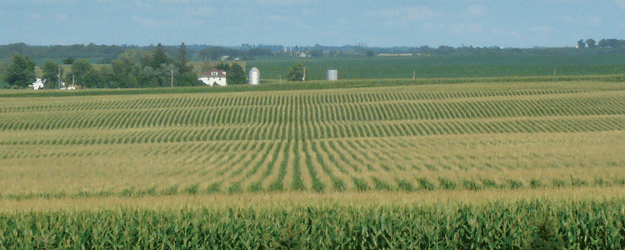Healthy Fields

The corn is high and the soybeans are thick.
That is one of the biggest observations from my 2014 summer research trip. Lush fields of tall corn and soybeans blanketed Indiana, Illinois, and Iowa. A milder summer with good rains after a wet winter has set the table for what looked to be a significant harvest that year.
As I rode through the secondary highways in Iowa and Indiana, I noticed that the corn was tall enough that I could not see out over the fields on level terrain, which means the stalks were at least nine feet tall. On a day with strong crosswinds from the north, the tall and densely planted fields provided significant wind protection. I can’t remember having ever seen corn fields tall enough or thick enough to provide protection from crosswinds.

I know from planting corn in my garden that density plays a role in the development of ears. The ear on the corn stalk is like a branch. The more room around a plant, the more likely the plant creates more branches. This has to do with how much light, water, and nutrients are available for each plant, and the way the plants' genes react to these conditions. Crowded plants have fewer resources, and are not going to produce many branches, but will grow vertically.
Seeing the dense planting, the height of the plants makes sense. However, seeing two ears on each stalk was unusual. The density of this commercial field was similar to many of the others I had seen over the course of my four days of travel through corn land, a density of 30 – 35 thousand plants per acre. There was no way I could walk through the field with the plants growing so close together.
Not able to leave it alone, I stopped at more fields along the way. After the fourth field I was no longer surprised at the density of the plants or the number of ears on each stalk. In each field, most plants had two harvestable ears of corn. Of the 11 fields I looked at closely, only one had one ear per stalk; the rest had two ears per stalk. My ride took me through Ohio, Indiana, Illinois, Iowa, and Minnesota. Add Nebraska to this list and you have 82 percent of all US corn production, so I can boast of having ridden through the heart of the Corn Belt. The ten-foot-high stalks with twin ears I had first seen in Illinois appeared again in all five states I passed through.
Double Your Production, Double Your Revenue?
Two ears instead of one doubles the yield of the field. Double the yield, and the farmer gets a bountiful harvest of corn. If this happens to one farmer, he can double his money if the prices hold. But if all the farmers enjoy double-ear stalks, the corn supply may exceed the demand, and the price drops. Doubling the harvest creates other problems besides price. At harvest, what does the farmer do with the extra corn? Does he have the storage for a double-sized harvest? Is there sufficient transportation capacity to move the grain from farm to elevator? Is there sufficient elevator capacity? Trains move most of the corn beyond the elevators; what kind of pressure does this put on the rail networks?
From my field research, I knew that the Corn Belt was looking at a record year. The favorable rain and weather conditions set the stage for Mother Nature to shift into high gear with the second ear per stalk. But what kind of trend did this bumper year build on? Could my observations have been taken from an unusual combination of outliers?
This is where we must reinforce field research with more research in other sources.
Market Driven News and Government Statistics
One of the places I turn to for better current information about commodity and financial markets is Bloomberg. Commodity traders throughout the food supply chain rely on accurate news about growing conditions, often from private information resources that develop data by working directly with the growers. If I traded commodities full time, I would invest in one of more of these information services. But I am not a commodity trader, so a more broadly distributed resource like Bloomberg works well.
Sure enough, I found a Bloomberg article that confirmed the corn bumper crop. Farmers reported per-acre yields of over 200 bushels per acre (BPA), far above the national average of about 150 BPA. One farmer featured in the article is counting his corn before harvest at 250 BPA, about 24 percent above his average over the past decade. The rain and milder weather created ideal growing conditions, causing prices to tumble and costs to fall for buyers of corn.
To get a grasp on how that year’s projects compared to the prior five years, I turned to the US Department of Agriculture Crop Statistics to understand the recent trends (see the table below). As with any government site, they work off of estimates based on surveys. How accurate is it? Perhaps accurate enough that the release of a farm estimate report can swing the price of any food commodity by double digits.
Prices tumbled because of the promise of an ample supply. The past performance data supports that notion. Demand for corn fell in 2009 and 2010, partly as result of the economic downturn, partly with the reduction of demand for ethanol. This combined reduction in demand was better then 10 percent under supply, helping to depress the price per bushel to under $4.00. The 2012 Midwest drought decimated per-acre yields, dropping the total by over 2 billion bushels — almost 13 percent. The price per bushel almost doubled from 2009 to 2012, demonstrating supply and demand.
Thanks to the Iowa State University Maize Page for some of the details about density and ear production.


